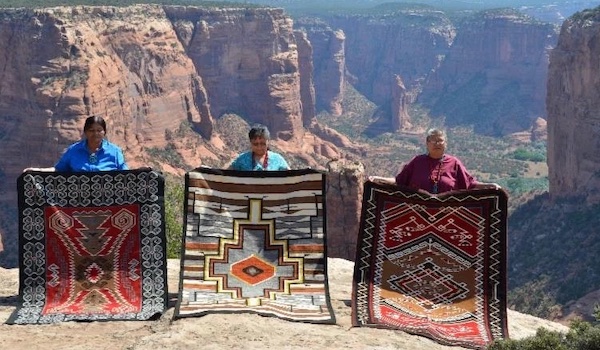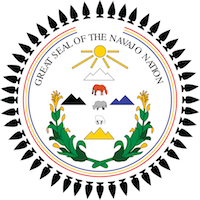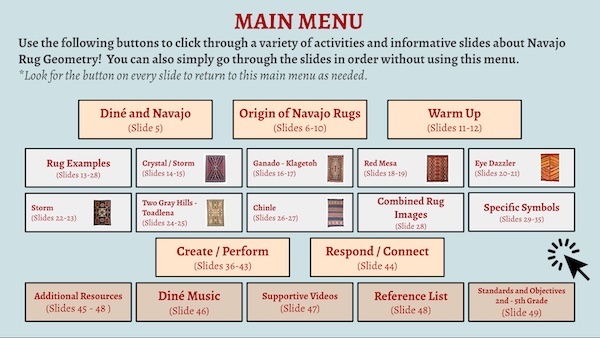SUBJECTS
GRADE
Show Results
Navajo Rug Geometry

Lesson Summary
- Observe geometric concepts from Navajo rugs.
- Explore the process of Navajo rug weaving through creative movement.
- Create movement sequences inspired by geometry found in Navajo rugs.
Lesson Plan and Procedure
Lesson Key Facts
- Grade(s): K, 1, 2, 3, 4, 5, 6
- Subject(s): Dance, Math, Social Studies, Native American, Tribe Approved
- Duration of lesson: 30 minutes
- Author(s): Brenda Whitehorse and Rachel Marie Kimball

The Navajo Nation’s Department of Diné Education selected this lesson content in answer to the question, “What would you like the students of Utah to know about you?” The Department of Diné Education is the education arm of the Navajo Nation. Brenda Whitehorse, the Heritage Language Director for the San Juan School District, was selected to help craft the lesson to provide expertise, accuracy, and authenticity. It was reviewed in depth by the Navajo Nation Department of Diné Education’s Office of Diné School Improvement and Office of Standards, Curriculum, and Assessment. The lesson received approval for publication with the tribal seal by the 2022 Navajo Nation Board of Education which approval was signed by the Navajo Nation President, Buu Nygren.
Before teaching this lesson, please explain to your students that there are many Native tribes in the United States and that this lesson specifically focuses on the Navajo Nation and does not represent other Native American groups. We hope other Native tribes will respect the Navajo Nation's choice to share this aspect of their culture.
We invite teachers to explore geometric concepts with their students through connecting with the Navajo culture and the process of Navajo rug weaving. Access the slide presentation to begin your adventure. This slide presentation is not a one-time lesson. It can be used several times in unique ways.

Before beginning the lesson or unit, identify which geometric concept to focus on.
Use every slide or pick and choose what you would like to do with your students.
Learning Objectives
- Identify geometric shapes and their defining attributes, including angles and rules of symmetry.
- Move in and out of formations in the shared space, using a variety of locomotor and axial motions.
Utah State Board of Education Standards
This lesson can be used to meet standards in many grades and subject areas. We will highlight one grade’s standards to give an example of application.
Grade 4 Dance
Standard 4.D.CR.2: Identify ideas for choreography generated from a variety of stimuli to solve given movement problems.
Standard 4.D.P.1: Establish spatial relationships with other dancers while safely using levels, directions, focus, and pathway designs in near-, mid-, and far range movement.
Standard 4.D.P.4: Demonstrate fundamental dance skills through locomotor and nonlocomotor sequences.
Standard 4.D.R.1: Use basic dance terminology to describe patterns of movement that create a style or theme.
Standard 4.D.CO.4: Select and describe movements in a specific genre or style, and explain how the movements relate to the culture, society, historical period, or community from which the dance originated.
Grade 4 Mathematics
Geometry (4.G.): Draw and identify lines and angles, as well as classify shapes by properties of their lines and angles (Standards 4.G.1–3)
Standard 4.G.1: Draw points, lines, line segments, rays, angles (right, acute, and obtuse), and perpendicular and parallel lines. Identify these in two-dimensional figures.
Standard 4.G.2: Classify two-dimensional figures based on the presence or absence of parallel or perpendicular lines, or the presence or absence of angles of a specified size. Recognize right triangles as a category, and identify right triangles.
Standard 4.G.3: Recognize a line of symmetry for a two-dimensional figure as a line across the figure such that the figure can be folded along the line into matching parts. Identify line-symmetric figures and draw lines of symmetry.
Grade 4 Social Studies
Standard 4.3.1: Use primary sources to compare experiences of at least three groups’ migration to Utah between 1847–1896 (for example, members of The Church of Jesus Christ of Latter-day Saints, people from Greece, Italy, China).
Standard 4.5.6: Choose one of Utah’s cultural institutions (for example Utah Symphony, The Tabernacle Choir at Temple Square, Utah Opera Company, Ballet West, Utah’s Shakespeare Festival, Utah Festival Opera), and explain its historical significance as well as the cultural benefits to Utah families and our nation.
Diné Standards
This lesson can be used to meet many Diné standards. The following are examples of application.
4th-6th Diné Character Building Standards
- Standard: K’ é hwiinidzin dóó ádáhozdílzin bee hadínísht’ée dooleełígíí bóhwiideesh’ááł.
I will develop and apply critical thinking to establish relationships with the environment.- Concept 2- Ádáhozdílzin.
I will maintain the sacredness of self-identity.- PO 1. Íínísts’ ą́ą’go binahjį’ bínashidi’neeztą́’ígíí choosh’į́į dooleeł.
I will listen to and apply Diné teachings.
- PO 1. Íínísts’ ą́ą’go binahjį’ bínashidi’neeztą́’ígíí choosh’į́į dooleeł.
- Concept 2- Ádáhozdílzin.
4th-6th Diné Culture Standards
- Standard: K’é dóó nitsáhákees dóó nahat’á náásgóó iiná bee siih hasingo ádoolnííł.
I will develop an understanding of Diné way of life.- Concept 1: Nitsáhá kees Shintsáhákees shił nilį́į go bee ádaa ákonisdzin dool eeł.
I will acknowledge and value my thoughts and personality.- PO 1: Diné be’é’ooĺįįł bóhoosh’aahgo binahjį’ ádił nishdlį́į dooleeł.
I will develop my cultural knowledge to build self worth. - PO 3: Nitł’iz ałtaas’éi baa ákonisin dóó baa hashne’ dooleeł.
I will explain the significance of my cultural posessions.
- PO 1: Diné be’é’ooĺįįł bóhoosh’aahgo binahjį’ ádił nishdlį́į dooleeł.
- Concept 1: Nitsáhá kees Shintsáhákees shił nilį́į go bee ádaa ákonisdzin dool eeł.
4th-6th Diné History Standards
- Standard: Diné bibee’é’ool’įįł dóó ádahóót’įįdígíí shił nilį́įgo ádídíínísht’i’ dooleeł.
I will understand historical/factual events, people and symbols that influence my family.- Concept 3: Nihinaagóó bitsį’ yishtłizhii kéédahat’ínígíí dóó shidine’é bahane’ ahąąh naashnilgo baa hashne’ dooleeł.
I will compare and contrast major historical events of Diné and neighboring tribes.- PO 2: Ałk’idą́ą́’ dóó dííshjį́įjį’ ádahóótįįdígíí ałhąąh naashnil dooleeł.
I will compare Diné and a neighboring tribe’s historical timeline.
- PO 2: Ałk’idą́ą́’ dóó dííshjį́įjį’ ádahóótįįdígíí ałhąąh naashnil dooleeł.
- Concept 3: Nihinaagóó bitsį’ yishtłizhii kéédahat’ínígíí dóó shidine’é bahane’ ahąąh naashnilgo baa hashne’ dooleeł.
Equipment and Materials Needed
- Navajo Rug Geometry slide presentation
- Possible Diné Music to Dance With:
- Radmilla Cody and Herman Cody: Niha’a’lyaa / A Gift to Us
- Radmilla Cody: Corn Grinding Song
- Radmilla Cody: Shi Naasha’
- Radmilla Cody: Grandmother
- Kansas K. Begaye: NAC Song
- Talibah Begay: Family Path Song
- Talibah Begay: Corn Pollen Path
- Talibah Begay: Family Song
- Sharon Burch: Cradle Song
- Sharon Burch: Earth Child
- Sharon Burch: Wee Play
- Navajo Weaver Videos
Additional Resources
This lesson was created thanks to a grant from the National Endowment for the Arts and the Utah Division of Arts & Museums.
- Navajo Nation website
- Additional rug images and weaving information from Nizhoni Ranch Gallery
https://www.navajorug.com
Image References
Image 1: Nizhoni Ranch Gallery, used with permission
© Brigham Young University and the Navajo Nation

www.education.byu.edu/arts/lessons
 Download
Download